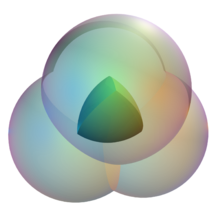Reuleaux tetrahedron
The Reuleaux tetrahedron is the intersection of four spheres with radius s , the four centers of which lie at the corners of a regular tetrahedron with side length s . The four corners of the generating tetrahedron also form the four corners of the Reuleaux tetrahedron. The Reuleaux tetrahedron has the same structure as its generating tetrahedron: four corners, four faces and six edges. However, the surfaces consist of spherical segments and the edges of circular segments .
The Reuleaux tetrahedron is defined and named after its 2-dimensional analogue, the Reuleaux triangle , which is named after Franz Reuleaux . In contrast to this, the Reuleaux tetrahedron is not a body of constant width , because the centers of two opposite edges are a greater distance away
The volume of the Reuleaux tetrahedron is
(Weisstein).
Meissner body
However, Ernst Meissner and Friedrich Schilling (1911, 1912) showed how the Reuleaux tetrahedron can be modified to form a body of constant width . To do this, three of the edges (consisting of circle segments) must be replaced by surfaces that are part of a solid of revolution. These bodies of revolution have the edge of the associated generating tetrahedron as their axis and a segment of a circle as the generating curve, which is created when the Reuleaux tetrahedron is intersected with the continued sides of the generating tetrahedron. Depending on which three edges are replaced (three with a common corner or three that form a triangle), two topologically different bodies arise, which are also called Meißner bodies (for films and interactive images see Weber). Tommy Bonnesen and Werner Fenchel (1934) hypothesized that the Meißner bodies are the bodies of constant width with minimal volume, but the proof is still open (Kawohl and Weber, 2011). Campi et al. (1996) were able to show that the solid of revolution with constant width and minimal volume is a Reuleaux triangle that rotates around one of its axes of symmetry .
literature
- Ernst Meissner: Via point sets of constant width . In: Vierteljahrsschr. Nat.forsch. Ges. Zurich . 56, 1911, pp. 42-50.
- Ernst Meissner, Friedrich Schilling: Three plaster models of surfaces of constant width . In: Z. Math. Phys . 60, 1912, pp. 92-94.
- Tommy Bonnesen , Werner Fennel : Theory of convex bodies . Springer-Verlag, 1934, pp. 127-139.
- Stefano Campi, Andrea Colesanti, Paolo Gronchi: Partial Differential Equations and Applications: Collected Papers in Honor of Carlo Pucci . In: Lecture Notes in Pure and Applied Mathematics . tape 177 . CRC Press, 1996, Minimum problems for volumes of convex bodies, p. 43-55 .
- Bernd Kawohl, Christof Weber: Meissner's Mysterious Bodies . In: Math. Intell . 33/3, 2011, pp. 94-101. doi : 10.1007 / s00283-011-9239-y .
Web links
- Thomas Lachand-Robert, Édouard Oudet: Spheroforms . Retrieved February 3, 2011.
- Christof Weber: What does this body have to do with balls? (PDF; 268 kB) 2006. Accessed on February 3, 2011. There are also films and interactive images of the two Meissner bodies.
- Eric W. Weisstein : Reuleaux Tetrahedron . In: MathWorld (English).



